In honor of Columbus Day this week, I decided to post a recipe for a typical dish found in the region of Liguria. Whether you are a fan of Cristoforo Colombo (Christopher Columbus) or not, he is an important figure in Italian history. The Ligurian city of Genoa was his birthplace and the birthplace of pesto alla Genovese. Travellers consider Liguria to be the Italian Riviera. One can hardly resist visiting picturesque Portofino, the Cinque Terre (five pastel-washed towns perched high above the sea), and my personal favorite, Portovenere.
It was on a sailboat trip to Portovenere and the Cinque Terre that I learned how to make this recipe from our skipper, Daniella. According to Daniella, this pasta dish is normally served with tomatoes in the summer and potatoes in the winter. Since she likes both, she taught me how to make it with tomatoes AND potatoes. It might sound strange to put potatoes with pasta, but there are quite a few dishes in Italy with potatoes in the sauce. My family loves it; just give it a try!
Ligurian Pasta with Tomatoes, Pesto, and Potatoes
Ingredients:
- 1 lb. (450 – 500 g.) fresh trofie or linguine pasta (12 – 14 oz. dry pasta can be substituted)
- 1-2 medium potatoes
- ½ cup pesto (see recipe below or you could use prepared pesto – but remember, “fresh is best”)
- 2 cups cherry or grape tomatoes, sliced in half
- 1/2 cup reserved pasta water
- Salt and pepper to taste
- Freshly-grated Parmesan for serving
Directions:
Bring a large pot of water to boil over high heat. Add about 2 teaspoons of salt per quart of water. (Unsalted pasta water makes the pasta bland. — (Don’t worry, you won’t ingest all of that salt!) Peel the potato. Slice in half lengthwise, then slice those pieces again lengthwise (see picture below). Cut small quarter-inch thick slices of the potato and add to the water that is coming to a boil.* Slice the 2 cups of tomatoes in half and set aside. When the water boils, add the pasta and cook until al dente. Package instructions for pasta usually tell you to cook the pasta for longer than it needs, so keep checking it. When ready, reserve about 1/2 cup of the pasta water and then drain off the rest. Immediately put the noodles and potatoes in a warmed bowl. Add the 1/2 cup of pesto and then some pasta water a little at a time to make the pesto mix in more easily. (You probably won’t need all the extra pasta water.) Add the fresh tomatoes and fold in. Add salt and pepper to taste. Grate a little Parmesan over each serving at the table. Enjoy!
*If you use dry pasta, add the potato along with the pasta after the water reaches a boil. Dry pasta takes longer to cook than fresh pasta.
It’s as easy as this:
Pesto alla Genovese
Ingredients:
- 1/4 cup pine nuts
- 2-3 garlic cloves (NOT peeled)
- 2 cups basil leaves (washed and dried — salad spinner works well for this)
- 1/4 – 1/2 tsp. sea salt (Pecorino is saltier than Parmesan so amount will vary with cheese used.)
- 1/2 cup olive oil (Ligurian is best for this recipe, but at least use a good quality olive oil.)
- 3/4 cup freshly grated Parmesan cheese
- 1/4 cup freshly grated Pecorino Romano cheese (regular Parmesan can be substituted)
Directions:
In a small skillet, toast the pine nuts on medium heat until slightly brown and fragrant. Set aside to cool. While the pan is still warm, toast the garlic cloves (still in their skin) in the same skillet.* Allow to roast on the heat for about 6-8 minutes, turning occasionally. Garlic is done when it is fragrant and just slightly soft. Once the garlic is cool enough to handle, peel off the skin. In the bowl of a food processor, put the basil leaves, cooled pine nuts, cooled garlic cloves, and salt. While the machine is running, add the olive oil in a steady stream. Stop to scrape down the sides of the bowl and pulse again to be sure everything is combined. Remove the puree to another bowl and stir in the Parmesan and Pecorino. Cover the surface of the pesto with plastic wrap to prevent discoloration and place in the refrigerator until ready to use.**
Try pesto on sandwiches or pasta. It works well as an appetizer when spread on toasted bread and topped with a slice of tomato.
*I cook the garlic a little just to mellow the flavor. If you don’t have the time, you can just peel it and add it to the food processor without cooking it at all.
**Pesto may be frozen in small portions for several months or kept in the refrigerator for a few days.
It’s as easy as this:

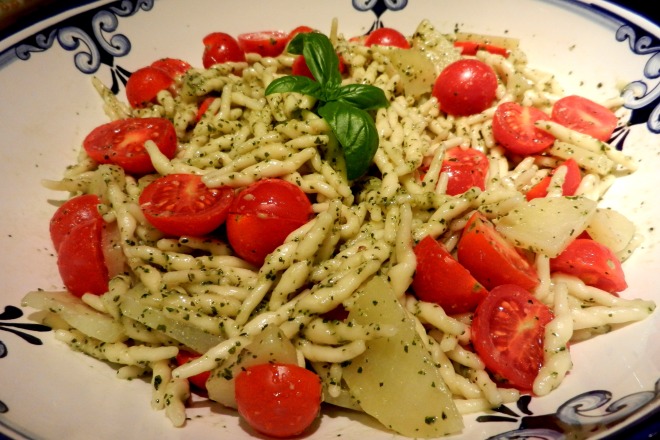
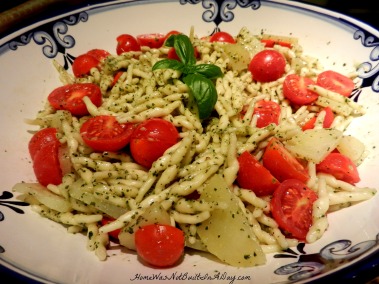
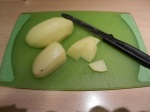
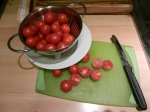
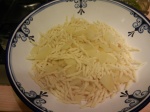

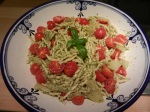
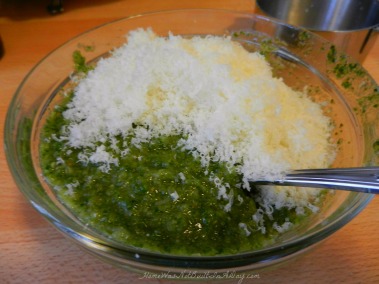
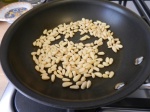
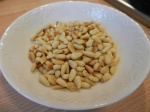
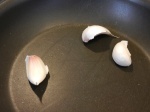
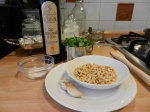
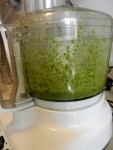
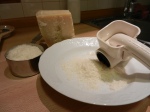
I love your pictures, I will definitely try this!
LikeLike
Let me know what you think!
LikeLike